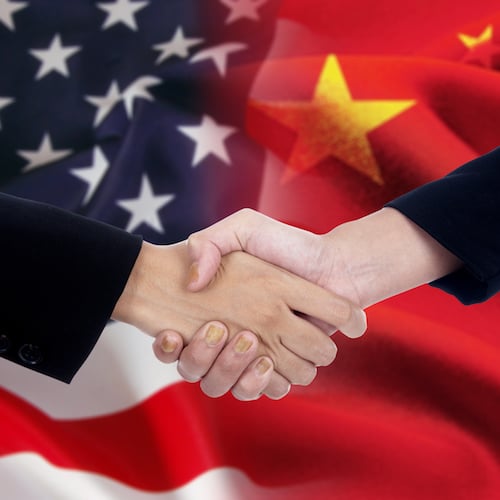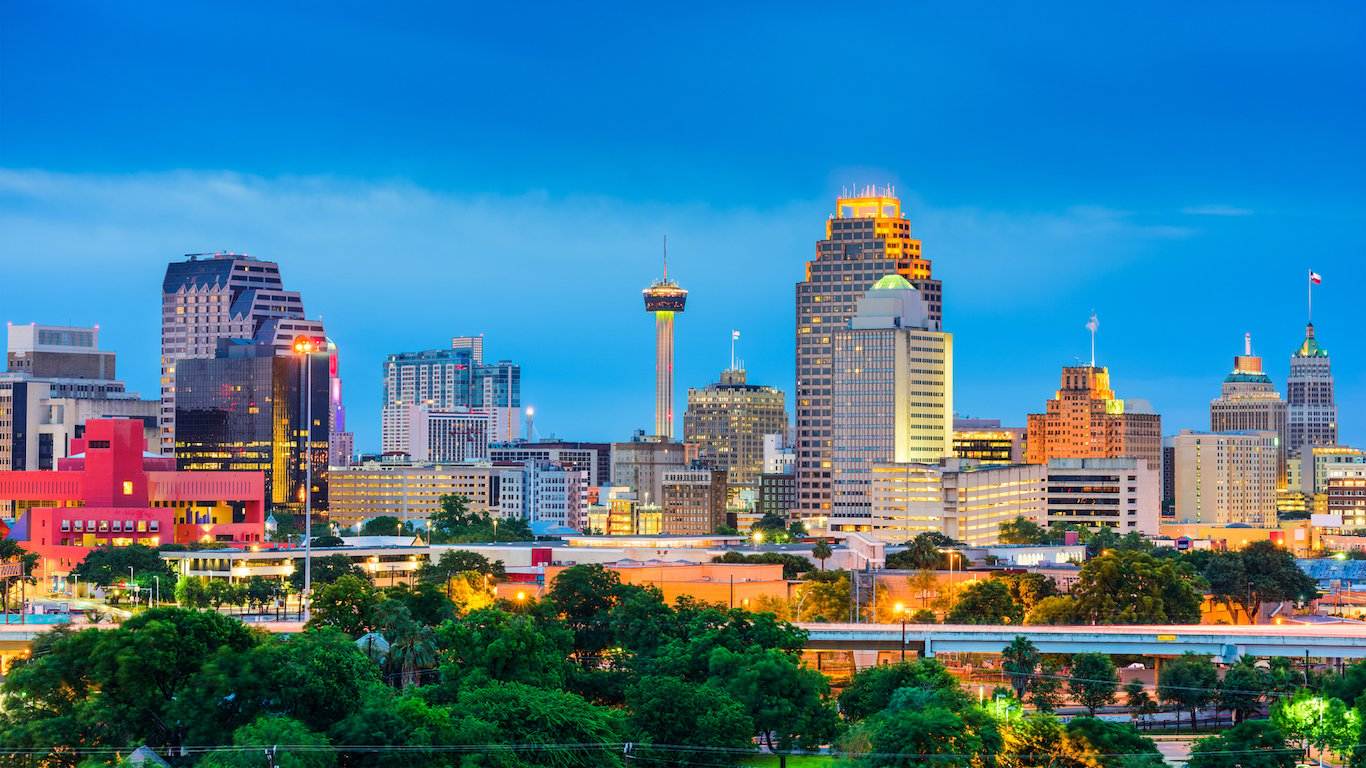Special Report
American Cities Where China Is Investing the Most

Published:
Last Updated:

Chinese investment in the United States hit an all-time high in 2016. That year, Chinese companies invested $46 billion in the country, more than triple the $15 billion investment in 2015. Just 12 major metropolitan areas attracted nearly half of all Chinese investment in the country since 2000.
To determine the U.S. cities where China is investing the most, 24/7 Wall St. analyzed data from the 2017 update to the nonprofit organization National Committee on U.S.-China Relations and economic research firm Rhodium Group’s New Neighbors report. Estimates are based on the Rhodium Group China Investment Monitor, which since 2000 has tracked all new Chinese greenfield projects, acquisitions of existing U.S. assets, and stakes in U.S companies worth 10% or more.
[in-text-ad]
With $13.9 billion in Chinese investment since 2000, the New York-Newark-Jersey City metro area is the top city for Chinese FDI.
Click here to see the American cities where China is investing the most.
Most new Chinese investment is in the form of mergers and acquisitions. Many Chinese investors purchase existing U.S. companies and maintain operations. One of the largest such acquisitions last year was the purchase of California-based Legendary Entertainment by Chinese conglomerate Dalian Wanda for $3.5 billion, the largest deal ever completed between Chinese and American parties in the motion picture industry.
The types of foreign direct investment that U.S. cities attract often reflect regional economic strengths. In the San Francisco metro area, for example, Chinese investment is largely focused on high-tech companies in Silicon Valley. In the Houston metro area, Chinese investments are primarily in the energy industry.
The total number of Americans employed by Chinese-owned companies in the United States rose to 141,000 in 2016, an increase of 50,000 from the year prior. While in many of the top cities for Chinese investment thousands of American workers are employed at Chinese-owned enterprises, the number of employees varies heavily among the cities on this list. Cities with large Chinese real estate holdings and other capital-intensive investments may have fewer workers than in cities where Chinese investments are more labor intensive.
For example, while the San Antonio metro area attracted the seventh most Chinese investment of any city, the 590 jobs supported by Chinese-owned establishments in the metro area ranks 34th. The discrepancy is likely due to the fact that much of the foreign direct investment in the area is in oil and gas fields, which require less human labor than businesses in sectors such as technology and consulting.
While Chinese investment reached an all-time high last year, the trend may not necessarily continue. Both U.S. and Chinese leaders have made public calls for increased scrutiny on deals between the two countries, with China citing the need to reduce capital flight and U.S. citing potential security concerns from increased Chinese presence in the American economy. In their annual report to Congress, the U.S.-China Economic Security Review Commission recommended a ban on Chinese state-owned enterprises from buying U.S. companies.
To determine the U.S. cities where China is investing the most, 24/7 Wall St. analyzed data from the 2017 update to the National Committee on U.S.-China Relations and Rhodium Group’s New Neighbors report. Data was aggregated from the 115th congressional districts to the county and metropolitan area levels using geographic definitions from the U.S. Census Bureau. As specific figures were not provided for Congressional districts in which Chinese investment totalled less than $50 million, jobs totalled less than 10, and operations were fewer than five, we excluded such districts from our analysis. Congressional districts do not align perfectly with county borders, and in some cases metropolitan level estimates may include Chinese investments located just outside metropolitan statistical area boundaries. The data is based on estimates from Rhodium Group’s China Investment Monitor, which since 2000 has tracked all new Chinese greenfield projects, acquisitions of existing US assets, and stakes in U.S companies worth 10% or more. Population data came from the U.S. Census Bureau’s American Community Survey and are for 2015.
These are the cities where China is investing the most.

12. Phoenix-Mesa-Scottsdale, AZ
> Total Chinese investment (2000-2016): $1.4 billion
> Jobs at Chinese-owned firms: 1,140
> Number of Chinese operations: 23
> Population: 4.4 million
The Phoenix-Mesa-Scottsdale metro area has attracted since 2000 some $1.4 billion foreign direct investment from China, the vast majority of total Chinese investment statewide of $1.6 billion. Real estate and financial services firms in particular have been major magnets for Chinese investment. About 5% of the the 25,200 people employed by Chinese companies in the Western United States work in the Phoenix-Mesa-Scottsdale metro area.
[in-text-ad]

11. Kansas City, MO-KS
> Total Chinese investment (2000-2016): $1.9 billion
> Jobs at Chinese-owned firms: 2,200
> Number of Chinese operations: 14
> Population: 2.1 million
Chinese foreign direct investment in the Kansas City metro area consists of a few major companies. In 2012, Chinese conglomerate Dalian Wanda acquired AMC, the largest movie exhibition company in the United States and the world, for $2.6 billion. The company’s headquarters are in Kansas City, where they have been for nearly a century. Smithfield Foods, which was acquired in 2013 for $4.7 billion by Chinese conglomerate WH Group — formerly known as Shuanghui International — also has several subsidiaries around the metro area.

10. Virginia Beach-Norfolk-Newport News, VA-NC
> Total Chinese investment (2000-2016): $1.9 billion
> Jobs at Chinese-owned firms: 3,430
> Number of Chinese operations: 10
> Population: 1.7 million
More than half of the $2.5 billion Chinese direct investment throughout Virginia is associated with Smithfield Foods, which is headquartered in Isle of Wight County — part of the Virginia Beach-Norfolk-Newport News metro area. The Chinese-owned WH Group purchased the food producer in 2013 — in what remains the largest-ever Chinese acquisition of a U.S. company — and maintains major operations in Smithfield and Toano, Virginia.

9. Boston-Cambridge-Newton, MA-NH
> Total Chinese investment (2000-2016): $2.0 billion
> Jobs at Chinese-owned firms: 740
> Number of Chinese operations: 37
> Population: 4.7 million
Chinese foreign investment in Massachusetts totalled $3.1 billion in the last 16 years. Most of the investment went to the Boston metro area. In addition to a number of high-tech investments in the region, New York-based real estate developer Tishman Speyer is currently partnered with Chinese insurance companies Ping An and China Life to develop Pier 4 in Boston’s Seaport District. The two companies are majority stakeholders in the $500 million project.
[in-text-ad]

8. Houston-The Woodlands-Sugar Land, TX
> Total Chinese investment (2000-2016): $2.1 billion
> Jobs at Chinese-owned firms: 1,720
> Number of Chinese operations: 64
> Population: 6.3 million
Most of the Chinese investments in the Houston metro area are in the energy industry. Nexen, a wholly-owned subsidiary of China National Offshore Oil Corporation, has a major regional office located in Houston. Additionally, Chinese-owned companies Friede Goldman and Sinochem have each made major investments in various drilling projects throughout the metro area. Chinese investment in Houston has totaled $2.1 billion since 2000, roughly one-fourth of the state total.

7. San Antonio-New Braunfels, TX
> Total Chinese investment (2000-2016): $2.2 billion
> Jobs at Chinese-owned firms: 590
> Number of Chinese operations: 12
> Population: 2.3 million
The San Antonio-New Braunfels metro area has attracted $2.2 billion in Chinese investment since 2000, roughly 28% of the total for Texas as a whole. One of the major sources of foreign direct investment in the metro area is IT consulting company Catapult Systems, which was acquired by ChinaSoft International Limited in 2013. Catapult Systems has an office in San Antonio.

6. Louisville/Jefferson County, KY-IN
> Total Chinese investment (2000-2016): $3.4 billion
> Jobs at Chinese-owned firms: 6,020
> Number of Chinese operations: <5
> Population: 1.3 million
Nearly 80% of all Chinese FDI in Kentucky goes to operations in the Louisville metro area. In one of the biggest deals in the area, Chinese appliance company Haier Group bought GE Appliances and its microfactory in Louisville in 2016. Also last year, another Chinese appliance company, Midea, began construction on a research and development center in Louisville. Upon completion, the center will add roughly 60 new jobs.
[in-text-ad]
5. Durham-Chapel Hill, NC
> Total Chinese investment (2000-2016): $3.6 billion
> Jobs at Chinese-owned firms: 4,180
> Number of Chinese operations: 17
> Population: 534,154
North Carolina is one of the largest recipients of Chinese investment in the United States. Lenovo, which in 2005 acquired IBM’s personal computing business in the Durham-Chapel Hill metro area, is the second largest Chinese employer in the state. In 2014, Lenovo also acquired IBM’s x86 server business, which is also located in Durham-Chapel Hill. Chinese investment in the metro area has totalled $3.6 billion since 2000, roughly 60% of the state total.

4. Chicago-Naperville-Elgin, IL-IN-WI
> Total Chinese investment (2000-2016): $4.2 billion
> Jobs at Chinese-owned firms: 4,240
> Number of Chinese operations: 125
> Population: 9.5 million
Roughly $4.2 billion of the $4.8 billion invested by Chinese enterprises in Illinois since 2000 has been within the Chicago-Naperville-Elgin metro area. In one major investment in 2014, Chinese agribusiness group New Hope acquired the Ruprecht Company, Chicago’s oldest beef processor. Other sources of Chinese investment include Wanxiang America, which has stakes in the Waldorf Astoria and in 150 Riverside Plaza, and Dalian Wanda, which in 2016 broke ground on what will be the third tallest building in the city upon completion.

3. San Francisco-Oakland-Hayward, CA
> Total Chinese investment (2000-2016): $7.7 billion
> Jobs at Chinese-owned firms: 9,460
> Number of Chinese operations: 222
> Population: 4.5 million
California has benefited from some $16.8 billion in investment from Chinese companies since 2000, the most of any state. Much of that money was invested in 2016 alone, and about 46% went to the San Francisco metro area. The highly skilled labor force in the Silicon Valley region has attracted investment from Chinese holding company Hanergy among a number of others. The company bought area solar cell manufacturer MiaSole in 2013 and solar power developer Alta Devices in 2014. Chinese companies are also heavily invested in finance firms, mobile technology development companies, and education companies throughout the metro area.
[in-text-ad]

2. Los Angeles-Long Beach-Anaheim, CA
> Total Chinese investment (2000-2016): $8.5 billion
> Jobs at Chinese-owned firms: 7,830
> Number of Chinese operations: 271
> Population: 13.2 million
Chinese investment in the Los-Angeles-Long Beach-Anaheim metro area has totalled $8.5 billion since 2000, roughly half of the $16.8 billion invested across the state. In one major investment in the metro area, Chinese conglomerate Dalian Wanda purchased Legendary Entertainment in 2016 for $3.5 billion. Chinese-owned operations employ a total of 7,830 workers in the metro area, the most of any U.S. city other than San Francisco.

1. New York-Newark-Jersey City, NY-NJ-PA
> Total Chinese investment (2000-2016): $13.9 billion
> Jobs at Chinese-owned firms: 6,590
> Number of Chinese operations: 240
> Population: 20.0 million
Chinese investment in the New York metro area over the last 16 years exceeds total Chinese FDI in most states. Last year, real estate investments were the primary drivers of growth. Perhaps most notably, China Investment Corporation purchased a 45% stake in a skyscraper on Sixth Avenue in a deal valued at $1.0 billion. Because so much Chinese investment in the New York City region is real estate-based, relatively few people are employed by Chinese companies when compared to the monetary value of Chinese FDI.
Finding a qualified financial advisor doesn’t have to be hard. SmartAsset’s free tool matches you with up to 3 fiduciary financial advisors in your area in 5 minutes. Each advisor has been vetted by SmartAsset and is held to a fiduciary standard to act in your best interests. If you’re ready to be matched with local advisors that can help you achieve your financial goals, get started now.
Thank you for reading! Have some feedback for us?
Contact the 24/7 Wall St. editorial team.